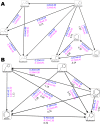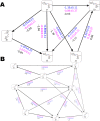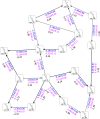An Improved Free Energy Perturbation FEP+ Sampling Protocol for Flexible Ligand-Binding Domains
- PMID: 31728038
- PMCID: PMC6856381
- DOI: 10.1038/s41598-019-53133-1
An Improved Free Energy Perturbation FEP+ Sampling Protocol for Flexible Ligand-Binding Domains
Abstract
Recent improvements to the free energy perturbation (FEP) calculations, especially FEP+ , established their utility for pharmaceutical lead optimization. Herein, we propose a modified version of the FEP/REST (i.e., replica exchange with solute tempering) sampling protocol, based on detail studies on several targets by probing a large number of perturbations with different sampling schemes. Improved FEP+ binding affinity predictions for regular flexible-loop motions and considerable structural changes can be obtained by extending the prior to REST (pre-REST) sampling time from 0.24 ns/λ to 5 ns/λ and 2 × 10 ns/λ, respectively. With this new protocol, much more precise ∆∆G values of the individual perturbations, including the sign of the transformations and decreased error were obtained. We extended the REST simulations from 5 ns to 8 ns to achieve reasonable free energy convergence. Implementing REST to the entire ligand as opposed to solely the perturbed region, and also some important flexible protein residues (pREST region) in the ligand binding domain (LBD) has considerably improved the FEP+ results in most of the studied cases. Preliminary molecular dynamics (MD) runs were useful for establishing the correct binding mode of the compounds and thus precise alignment for FEP+ . Our improved protocol may further increase the FEP+ accuracy.
Conflict of interest statement
The authors declare no competing interests.
Figures









References
Publication types
LinkOut - more resources
Full Text Sources
Miscellaneous

